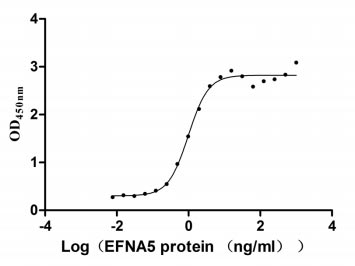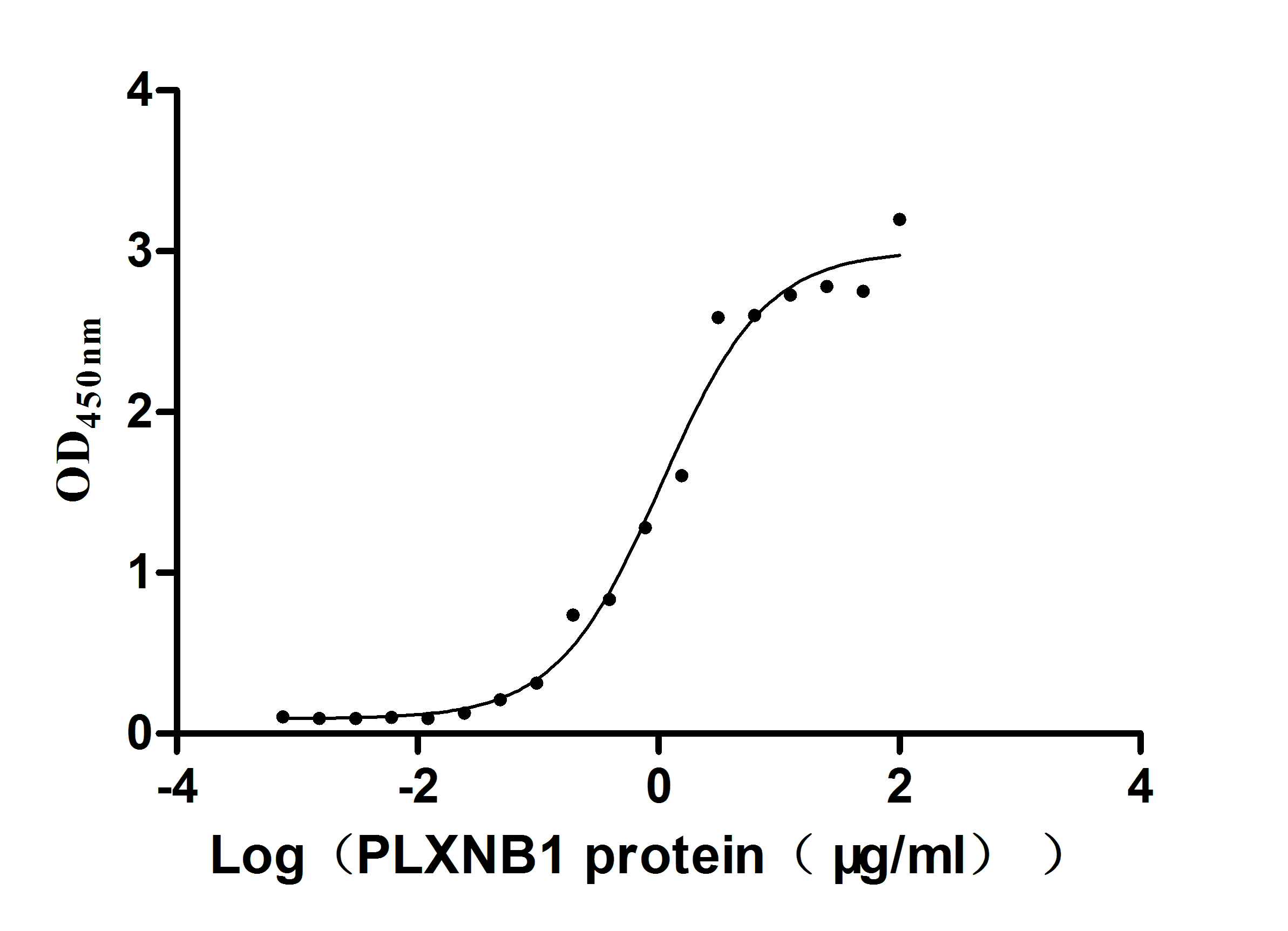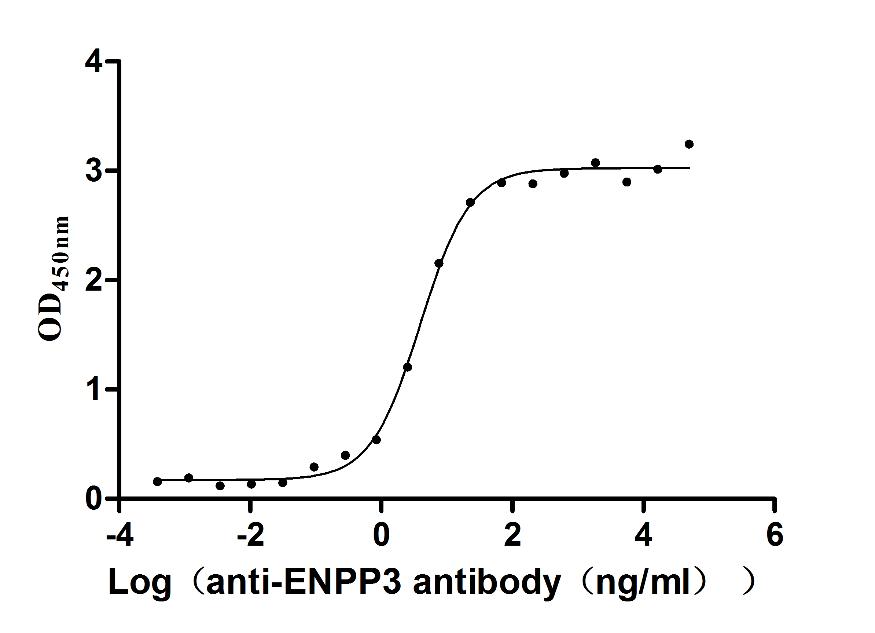Recombinant Human Guanine nucleotide-binding protein G (q) subunit alpha (GNAQ)
-
货号:CSB-YP342271HU
-
规格:
-
来源:Yeast
-
其他:
-
货号:CSB-EP342271HU-B
-
规格:
-
来源:E.coli
-
共轭:Avi-tag Biotinylated
E. coli biotin ligase (BirA) is highly specific in covalently attaching biotin to the 15 amino acid AviTag peptide. This recombinant protein was biotinylated in vivo by AviTag-BirA technology, which method is BriA catalyzes amide linkage between the biotin and the specific lysine of the AviTag.
-
其他:
-
货号:CSB-BP342271HU
-
规格:
-
来源:Baculovirus
-
其他:
-
货号:CSB-MP342271HU
-
规格:
-
来源:Mammalian cell
-
其他:
产品详情
-
纯度:>85% (SDS-PAGE)
-
基因名:
-
Uniprot No.:
-
别名:CMC1; G alpha Q; G protein alpha Q; G protein subunit alpha q; G-ALPHA-q; GAQ; GNAQ; GNAQ_HUMAN; guanine nucleotide binding protein (G protein); q polypeptide; Guanine nucleotide binding protein alpha q; guanine nucleotide binding protein G protein q polypeptide; Guanine nucleotide binding protein G q subunit alpha; Guanine nucleotide-binding protein alpha-q; Guanine nucleotide-binding protein G(q) subunit alpha; SWS
-
种属:Homo sapiens (Human)
-
蛋白长度:full length protein
-
表达区域:1-359
-
氨基酸序列MTLESIMACC LSEEAKEARR INDEIERQLR RDKRDARREL KLLLLGTGES GKSTFIKQMR IIHGSGYSDE DKRGFTKLVY QNIFTAMQAM IRAMDTLKIP YKYEHNKAHA QLVREVDVEK VSAFENPYVD AIKSLWNDPG IQECYDRRRE YQLSDSTKYY LNDLDRVADP AYLPTQQDVL RVRVPTTGII EYPFDLQSVI FRMVDVGGQR SERRKWIHCF ENVTSIMFLV ALSEYDQVLV ESDNENRMEE SKALFRTIIT YPWFQNSSVI LFLNKKDLLE EKIMYSHLVD YFPEYDGPQR DAQAAREFIL KMFVDLNPDS DKIIYSHFTC ATDTENIRFV FAAVKDTILQ LNLKEYNLV
-
蛋白标签:Tag type will be determined during the manufacturing process.
The tag type will be determined during production process. If you have specified tag type, please tell us and we will develop the specified tag preferentially. -
产品提供形式:Lyophilized powder
Note: We will preferentially ship the format that we have in stock, however, if you have any special requirement for the format, please remark your requirement when placing the order, we will prepare according to your demand. -
复溶:We recommend that this vial be briefly centrifuged prior to opening to bring the contents to the bottom. Please reconstitute protein in deionized sterile water to a concentration of 0.1-1.0 mg/mL.We recommend to add 5-50% of glycerol (final concentration) and aliquot for long-term storage at -20℃/-80℃. Our default final concentration of glycerol is 50%. Customers could use it as reference.
-
储存条件:Store at -20°C/-80°C upon receipt, aliquoting is necessary for mutiple use. Avoid repeated freeze-thaw cycles.
-
保质期:The shelf life is related to many factors, storage state, buffer ingredients, storage temperature and the stability of the protein itself.
Generally, the shelf life of liquid form is 6 months at -20°C/-80°C. The shelf life of lyophilized form is 12 months at -20°C/-80°C. -
货期:Delivery time may differ from different purchasing way or location, please kindly consult your local distributors for specific delivery time.Note: All of our proteins are default shipped with normal blue ice packs, if you request to ship with dry ice, please communicate with us in advance and extra fees will be charged.
-
注意事项:Repeated freezing and thawing is not recommended. Store working aliquots at 4°C for up to one week.
-
Datasheet :Please contact us to get it.
相关产品
靶点详情
-
功能:Guanine nucleotide-binding proteins (G proteins) are involved as modulators or transducers in various transmembrane signaling systems. Regulates B-cell selection and survival and is required to prevent B-cell-dependent autoimmunity. Regulates chemotaxis of BM-derived neutrophils and dendritic cells (in vitro). Transduces FFAR4 signaling in response to long-chain fatty acids (LCFAs).
-
基因功能参考文献:
- Gq protein-coupled receptors-induced apoptosis is general, and includes a two-branched pathway downstream of PKC. One branch consists on c-Src activation that transmit the signal to the JNK cascade and the second branch that consists on PKC-dependent inactivation of AKT and a phosphatase activity. PMID: 30278445
- data suggest that Galphaq is involved in Primary Sjogren's syndrome pathogenesis regulation, possibly due to its regulation of Th17 PMID: 29977933
- common conjunctival melanocytic nevi have mutually exclusive mutations in BRAF and NRAS. The two conjunctival blue nevi harbored GNAQ mutations. This suggests the driver mutations of conjunctival nevi are similar to those of nevi of the skin. At the molecular level, conjunctival nevi appear more like cutaneous nevi than choroidal nevi PMID: 29332123
- The results show that postzygotic mosaicism for GNAQ mutations causes an overlapping phenotypic spectrum of vascular and melanocytic birthmarks. PMID: 28083870
- Results demonstrate that the somatic GNAQ mutation in Sturge-Weber syndrome is not confined to the venous vascular malformation but can directly (although less severely) affect underlying brain parenchyma, not directly affected by leptomeningeal angiomatosis, and possibly contribute to Sturge-Weber syndrome brain pathology. PMID: 28571101
- We conclude that the crosstalk between angiotensin AT1 receptor and insulin receptor signaling shows a high degree of specificity, and involves Galphaq protein, and activation of distinct kinases. Thus, the BRET(2) technique can be used as a platform for studying molecular mechanisms of crosstalk between insulin receptor and 7TM receptors. PMID: 28854843
- Nine of 13 cases (69%) of anastomosing hemangiomas harbored a somatic mutation at GNAQ codon 209 PMID: 28084343
- It is therefore concluded that Gnaq plays a pivotal role in antioxidation in neural cells. A possible mechanism for this would be that the overexpressed Gnaq inhibits the cellular damaging effect mediated by NF-kappaB and Erk1/2 signal pathways. PMID: 28369206
- Parathyroid hormone controls bone and kidney homeostasis via GNAS and Gq-G11 heterotrimeric G proteins. (Review) PMID: 28363951
- we report a previously unknown role for Gaq in maintenance of MLL-AF9-induced acute myeloid leukemia leukemia PMID: 26859074
- Study demonstrated that the GNAQ p.R183Q mutation resides within endothelial cells in Sturge-Weber syndrome (SWS) brain lesions, and that the SWS brain endothelial cells can be isolated and expanded in culture and further confirm that the GNAQ p.R183Q mutation is present in brain endothelial cells. PMID: 27919468
- Phospholipase C beta connects G protein signaling with RNA interference. (Review) PMID: 26746047
- These results indicate that the mechanism by which Galphaq and PLC-beta3 mutually regulate each other is far more complex than a simple, two-state allosteric model and instead is probably kinetically determined. PMID: 28842497
- Data (including data from studies using cells from knockout mice) suggest that CLEC2/CLEC2R signaling is dependent on thromboxane A2 generation and is potentiated by co-stimulation with different GNAQ agonists. (CLEC2 = C-type lectin CLEC2; CLEC2R = CLEC2 receptor; GNAQ = guanine nucleotide-binding protein G[q] subunit alpha) PMID: 28705934
- The findings of the work indicate a role for Galphaq and/or Galpha14 and in CCR2a/CCR2b-stimulated Rho A GTPase-mediated serum response factor activation. PMID: 26823487
- GNAQ/11 mutant clones make up a fraction of the cells in choroidal nevi. Nevus cells are furthermore characterised by heterogeneous YAP expression. Combined GNAQ/11 and YAP may constitute a putative precursor tumour pathway with an activated oncogene (GNAQ/11) and downstream effector (YAP). PMID: 28809862
- RasGRP3 mediates ERK MAPK pathway activation in GNAQ mutant uveal melanoma. PMID: 28486107
- Galphaq regulates the development of rheumatoid arthritis by modulating Th1 differentiation PMID: 28197018
- The GC/GC genotype of the TT(-695/-694)GC polymorphism is associated with increased Gq protein expression, augmented angiotensin II receptor type 1-related vasoconstriction, and increased myocardial injury after coronary artery bypass grafting. PMID: 28422819
- Data suggest that allosteric communication between heterodimeric AT1R and PTGFR is mediated through GNAQ and may also involve proximal phospholipase C but not distal protein kinase C signaling partners; PTGFR activation has negligible effects on AT1R-based conformational biosensors. (AT1R = angiotensin II receptor, type 1; PTGFR = prostaglandin F2alpha receptor; GNAQ = GTP-binding protein G[q] subunit alpha) PMID: 28584054
- Results found that GNAQ was highly expressed in gastric cancer (GC) patient samples and suggest that GNAQ plays a critical role in regulating GC cell growth and survival via canonical oncogenic signaling pathways including MAPK and p53. PMID: 28350126
- These findings suggest that Galphaq/11 participates in the sensing/transducing of shear stress independently of GPCR activation in ECs. PMID: 28148497
- The Galphas and Galphaq peptides adopt different orientations in beta2-AR and V1AR, respectively. The beta2-AR/Galphas peptide interface is dominated by electrostatic interactions, whereas the V1AR/Galphaq peptide interactions are predominantly hydrophobic. PMID: 27330078
- Data show that GNAQ promotes ARF6 activation to control the proliferation of Uveal Melanoma Cells. PMID: 27265506
- data suggest that the interaction between this novel region in Galphaq and the effector PKCzeta is a key event in Galphaq signaling. PMID: 26887939
- The Glu209 GNAQ and GNA11 missense variants we identified are common in uveal melanoma and have been shown to constitutively activate MAPK and/or YAP signaling. Our data indicate that chorangioma is probably not the placental counterpart of congenital hemangiomas associated with mutations altering Gln209 in GNAQ or GNA11. PMID: 27058448
- findings demonstrate that hNPS-(1-10) is a biased agonist favoring Galphaq-dependent signaling. It may represent a valuable chemical probe for further investigation of the therapeutic potential of human NPS receptor-directed signalingin vivo. PMID: 26865629
- Galphaq expression was negatively associated with interleukin-17A expression in RA patients, indicating that Galphaq negatively controlled the differentiation of Th17 cells. PMID: 25732870
- We conclude that enrichment of GNAQ (R183Q) in port-wine stain (PWS) blood vessels may induce consecutive activation of c-Jun N-terminal kinases and extracellular signal regulated kinases, thus contributing to the pathogenesis of PWS. PMID: 26775782
- This is the second largest study on isolated, non-syndromic Port-wine stain; data suggest that GNAQ is the main genetic determinant in this condition. Moreover, isolated port-wine stains are distinct from capillary malformations seen in RASA1 disorders. PMID: 26192947
- The results suggested that GNAQ mutation induced viability and migration of uveal melanoma cells via Notch signaling activation, which is mediated by YAP dephosphorylation and nuclear translocation. PMID: 25955651
- This study demonstrated that the GNAQ protein was reduced in auditory cortex patient with schizophreia. PMID: 25433904
- Oncogenic GNAQ mutation is associated with uveal melanoma. PMID: 25280020
- Diacylglycerol mediates regulation of TASK1 and TASK3 potassium channels by GNAQ. PMID: 25420509
- Knockdown of GNAQ with siRNA-AuNPs effectively reduced downstream signals and decreased cell viability in GNAQ mutant uveal melanoma cells. PMID: 25653058
- These findings suggest that the recurrent somatic GNAQ mutation c.548G>A is the major determinant genetic factor for Sturge-Weber syndrome and imply that other mutated candidate gene(s) may exist in Sturge-Weber syndrome PMID: 25374402
- Gaq controls the apoptosis of rheumatoid arthritis peripheral blood lymphocytes through regulating the activity of Mcl-1 and caspase-3. PMID: 21923740
- no GNAQ mutations were observed in African acral melanomas PMID: 25363280
- Results uncovered that Gaq binding to GRK2 enhances the recruitment of GRK2 to M3-ACh receptors. PMID: 25316767
- Melanocytes use an ultraviolet radiation phototransduction mechanism involving the GNAQ cascade. PMID: 24470488
- GNAQ oncogenic signaling induced YPA nuclear translocation and YAP-dependent transcription activation throuch Rho-GTPases and actin remodeling. PMID: 24882515
- There was no association of GNAQ mutation status with metastatic status in uveal melanoma. PMID: 24970262
- Our finding of the frameshift deletion (p.H387fs) in exon 4 of SOX10 in uveal melanoma (UM) provides an important insight and complements earlier findings of mutations in GNAQ and SF3B1 on the genomic basis of UM. PMID: 24927141
- PKC inhibitors combined with IR significantly decreased the viability, proliferation, and clonogenic potential of GNAQ(mt), but not GNAQ(wt)/BRAF(mt) cells, compared with IR alone. PMID: 24595385
- observations support the concept of a functional activation-dependent p63RhoGEF-Galphaq-RGS2 complex PMID: 24299002
- Signaling efficiency of Galphaq through its effectors p63RhoGEF and GEFT depends on their subcellular location. PMID: 23884432
- In primary melanocytic tumours of the CNS, GNA11 and N-RAS mutations represent a mechanism of MAPK pathway activation alternative to the common GNAQ mutations PMID: 22758774
- the GNAQ promoter polymorphism is not a genetic risk factor for rheumatoid arthritis in the Han Chinese population. PMID: 23315865
- GNAQ mutations are present in uveal melanocytomas and in a case of transformation to melanoma, implicating GNAQ-dependent mitogen activation signals, in the pathogenesis of uveal melanocytoma. PMID: 23685997
- Letter/Case Report: oncogenic GNAQ mutation in congenital choroidal melanoma. PMID: 23572156
显示更多
收起更多
-
相关疾病:Capillary malformations, congenital (CMC); Sturge-Weber syndrome (SWS)
-
亚细胞定位:Cell membrane; Lipid-anchor. Golgi apparatus. Nucleus. Nucleus membrane.
-
蛋白家族:G-alpha family, G(q) subfamily
-
组织特异性:Predominantly expressed in ovary, prostate, testis and colon. Down-regulated in the peripheral blood lymphocytes (PBLs) of rheumatoid arthritis patients (at protein level).
-
数据库链接:
HGNC: 4390
OMIM: 163000
KEGG: hsa:2776
STRING: 9606.ENSP00000286548
UniGene: Hs.269782
Most popular with customers
-
Recombinant Human Ephrin-A5 (EFNA5) (Active)
Express system: Mammalian cell
Species: Homo sapiens (Human)
-
Recombinant Human Plexin-B1 (PLXNB1), partial (Active)
Express system: Mammalian cell
Species: Homo sapiens (Human)
-
Express system: Mammalian cell
Species: Macaca fascicularis (Crab-eating macaque) (Cynomolgus monkey)
-
Recombinant Human Carcinoembryonic antigen-related cell adhesion molecule 6 (CEACAM6) (Active)
Express system: Mammalian cell
Species: Homo sapiens (Human)
-
Recombinant Human Myosin regulatory light polypeptide 9 (MYL9) (Active)
Express system: Yeast
Species: Homo sapiens (Human)
-
Recombinant Mouse Gastric inhibitory polypeptide receptor (Gipr), partial (Active)
Express system: Mammalian cell
Species: Mus musculus (Mouse)
-
Recombinant Human CUB domain-containing protein 1 (CDCP1), partial (Active)
Express system: Mammalian cell
Species: Homo sapiens (Human)
-
Recombinant Human Serotransferrin(TF) (Active)
Express system: Mammalian cell
Species: Homo sapiens (Human)




















